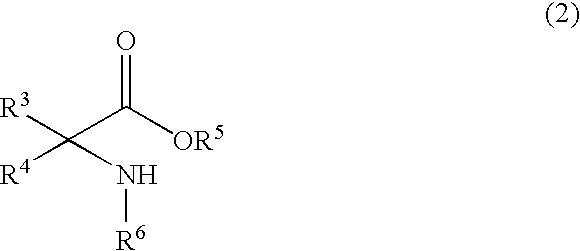Process for producing amino acid n-carboxyanhydride
a technology of n-carboxyanhydride and amino acid, which is applied in the preparation of carboxylic acid nitrile, carbamic acid derivatives, organic chemistry, etc., can solve the problems of phosgene use severely restricted, industrial utilization of amino acid n-carboxyanhydride is thus limited, and method (ii) is industrially accompanied by a drawback
- Summary
- Abstract
- Description
- Claims
- Application Information
AI Technical Summary
Benefits of technology
Problems solved by technology
Method used
Image
Examples
example 2
(Synthesis of N-Carboxyphenylalanine Anhydride)
[0059] Into a two-neck round-bottom flask having a capacity of 25 mL and equipped with a Dimroth condenser were introduced 165 mg (1 mmol) of phenylalanine and 10 mL of tetrahydrofuran in a nitrogen atmosphere. To the resultant solution was added 394 mg (1 mmol) of bis(2,4-dinitrophenyl) carbonate. The mixture was stirred at 60° C. for 91 hours.
[0060] This reaction mixture was analyzed by NMR spectroscopy using dioxane as an internal reference. As a result, it was ascertained that N-carboxyphenylalanine anhydride had been obtained in a yield of 100%.
example 3
(Synthesis of N-Carboxyphenylalanine Anhydride)
[0061] Into a two-neck round-bottom flask having a capacity of 25 mL and equipped with a Dimroth condenser were introduced 165 mg (1 mmol) of phenylalanine and 10 mL of tetrahydrofuran in a nitrogen atmosphere. To the resultant solution was added 396 mg (1 mmol) of bis(pentafluorophenyl) carbonate. The mixture was stirred at 60° C. for 60 hours.
[0062] This reaction mixture was analyzed by NMR spectroscopy using dioxane as an internal reference. As a result, it was ascertained that N-carboxyphenylalanine anhydride had been obtained in a yield of 56%.
example 4
(Synthesis of N-Carboxyisoleucine Anhydride)
[0063] Into a two-neck round-bottom flask having a capacity of 25 mL and equipped with a Dimroth condenser were introduced 131 mg (1 mmol) of isoleucine and 10 mL of tetrahydrofuran in a nitrogen atmosphere. To the resultant solution was added 304 mg (1 mmol) of bis(4-nitrophenyl) carbonate The mixture was stirred at 60° C. for 67 hours.
[0064] This reaction mixture was analyzed by NMR spectroscopy using dioxane as an internal reference. As a result, it was found that N-carboxyisoleucine anhydride had been obtained in a yield of 32%. Furthermore, this reaction mixture was subjected to column isolation to obtain N-carboxyisoleucine anhydride in an amount of 44 mg (isolation yield, 28%).
[0065] Spectral data for the N-carboxyisoleucine anhydride: 1H NMR (CDCl3) δ: 0.97 (t, J=7.4 Hz, 3H), 1.06 (d, J=6.8 Hz, 3H), 1.32-1.56 (m, 2H), 1.93-2.03 (m, 1H), 4.28-4.30 (m, 1H, —CH13C NMR (CDCl3) δ: 11.29, 14.72, 24.18, 37.27, 62.38, 153.51, 168.85.
[...
PUM
| Property | Measurement | Unit |
|---|---|---|
| reaction temperature | aaaaa | aaaaa |
| temperature | aaaaa | aaaaa |
| adsorption | aaaaa | aaaaa |
Abstract
Description
Claims
Application Information
 Login to View More
Login to View More - R&D
- Intellectual Property
- Life Sciences
- Materials
- Tech Scout
- Unparalleled Data Quality
- Higher Quality Content
- 60% Fewer Hallucinations
Browse by: Latest US Patents, China's latest patents, Technical Efficacy Thesaurus, Application Domain, Technology Topic, Popular Technical Reports.
© 2025 PatSnap. All rights reserved.Legal|Privacy policy|Modern Slavery Act Transparency Statement|Sitemap|About US| Contact US: help@patsnap.com



